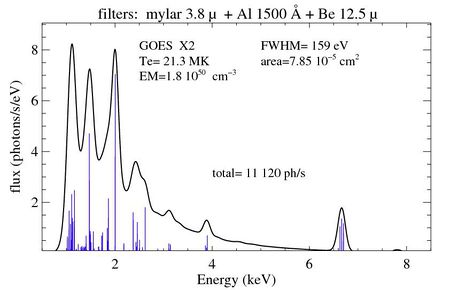The SphinX Instrument on CORONAS-PHOTON
From RHESSI Wiki
| Nugget | |
|---|---|
| Number: | 87 |
| 1st Author: | Janusz Sylwester |
| 2nd Author: | Ken Phillips |
| Published: | 22 October 2008 |
| Next Nugget: | SEPs Link not Confirmed |
| Previous Nugget: | The Good Guys and the Rascals |
| List all | |
Contents |
Introduction
SphinX is an X-ray spectrophotometer that will be launched on the Russian solar spacecraft CORONAS-PHOTON as part of the TESIS instrument package. CORONAS-PHOTON is due for launch in late December 2008, and preparations are now at an advanced stage. SphinX will measure the total solar X-ray flux though three different apertures with nearly identical PIN detectors. SphinX will have an overall dynamic range of 7 orders of magnitude -- from a small fraction of GOES class A1 to GOES class X30 -- and will have an energy range 0.8 keV to 15 keV. It will have a 5% absolute photometric accuracy, so unlike GOES SphinX will be able to observe X-ray emission from the quiet Sun, as well as from all forms of solar activity. It should mark a significant step in the complete monitoring of solar X-ray emission, and with its 290-490 eV spectral resolution should enable element abundances to be measured from the line features it observes.
Aims of the instrument
The main aim of the SphinX instrument is to measure element abundances in a variety of solar conditions from line features in the solar spectrum, and to study physical conditions in flares. SphinX will provide a flare flag (alert) for TESIS and other CORONAS-PHOTON instruments.
SphinX will be part of the TESIS telescope and spectrometer complex developed at the Lebedev Physical Institute, Moscow (PI Dr. Sergey Kuzin). It will have three apertures with areas 19.96, 0.397, 0.0785 mm2, the widely different sizes ensuring that a large range of solar activity can be measured. The field of view will be 5 degrees, so the total emission out to 10 solar radii can in principle be measured. The instrument's mass is 3.7 kg, power requirements 10 W (maximum), and it will produce some 50 MB of telemetry in 24 hours.
One of the reasons for SphinX is that at present the [GOES photometers] do not measure the 0.5-4 A (3-20 keV) solar irradiance accurately because of the low level of solar activity. The SphinX X-ray detectors are pure Si PIN detectors, about 20 mm2 area and 500 microns thickness cooled with Peltier devices to 50 degrees below the detectors' support temperature. They will have a spectral resolution of between 290 eV (detectors D2, D3, D4) and 490 eV (detector D1), so a large improvement on RHESSI's spectral resolution (approximately 1 keV). See Fig. 2 for a simulated X-ray flare spectrum. Similar detectors have already been used in the Mars Pathfinder mission for mineral spectroscopy, and other space missions.
Performance
The image to the left shows a model spectrum. The discrete lines at the bottom come from the [CHIANTI] database of atomic transitions, coupled to an estimation of the ionization states of the elements via an equilibrium collisional equilibrium calculation. The smoother curve at the top shows the same spectrum at the approximate spectral resolution of the PIN detectors. Many features from different elements can be recognized in this example, which is for a specific temperature (21.3 MK, or kT about 2 keV). Note that this simulation shows the response of the smallest of the three SphinX detectors, and the counting rate even for this powerful flare (GOES X2) is still reasonable. The larger-area detectors will have comparable counting rates for weaker flares.
Instrument and spacecraft
The figure to the right shows the instrument layout of SphinX integrated into its host TESIS.
CORONAS-PHOTON will be the last of the CORONAS series of Russian spacecraft designed to study solar and magnetospheric physics (CORONAS-I and CORONAS-F were launched in 1994 and 2001 respectively). The orbit will be circular, about 550 km altitude, and semi-Sun-synchronous -- there will be up to 20 days of uninterrupted sunlight, twice a year. The SphinX project is being undertaken by a Consortium including two Russian institutes MEPhI, FIAN (P.N. Lebedev Physical Institute), the Astronomical Institute, Czech Acad. Sci. (Dr. F.Farnik), and INAF-Palermo Astronomical Observatory (Prof. F. Reale).
Conclusions
Expected firsts for SphinX
- SphinX will measure absolute element abundances using line features due to neon, magnesium, silicon, sulphur, argon, calcium, iron and nickel in various levels of solar activity (quiet Sun, active regions and flares). It should therefore be in a strong position to give a definitive answer to the continuing debate about the dependence of coronal abundances of elements on their first ionization potential, the so-called FIP effect.
- SphinX will obtain the first absolutely calibrated solar X-ray spectra in the 0.8--15 keV range. In particular this will help us to understand the RHESSI continuum observations in this difficult range.
- SphinX will also study quiet coronal heating processes via photon arrival time--distance analysis (the arrival time of an X-ray photon will be measured to a couple of microseconds); X-ray oscillations in the <1 to 500 s period range; and transient ionization in flares.
| RHESSI Nugget Date | 22 October 2008 + |
| RHESSI Nugget First Author | Janusz Sylwester + |
| RHESSI Nugget Index | 87 + |
| RHESSI Nugget Second Author | Ken Phillips + |


